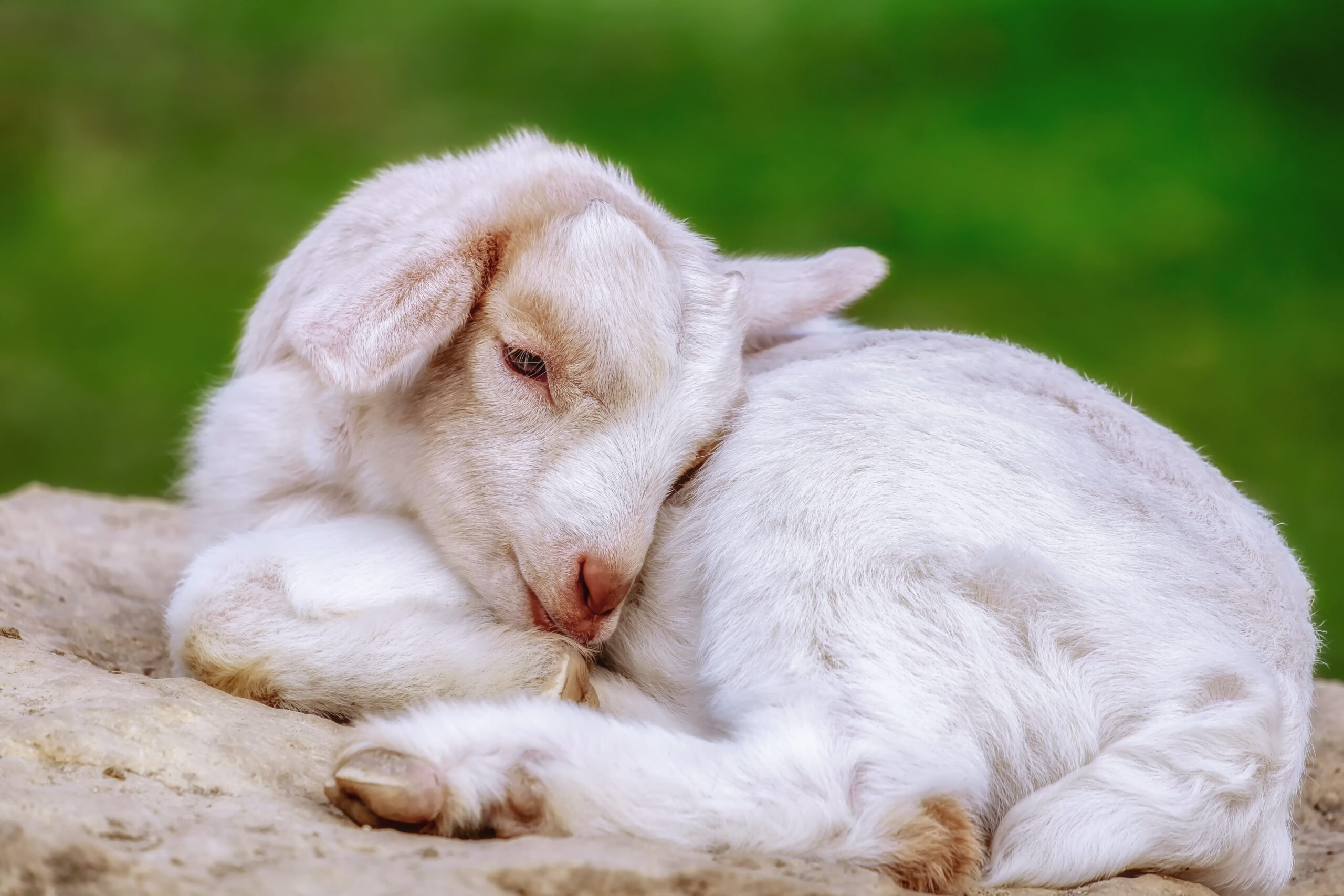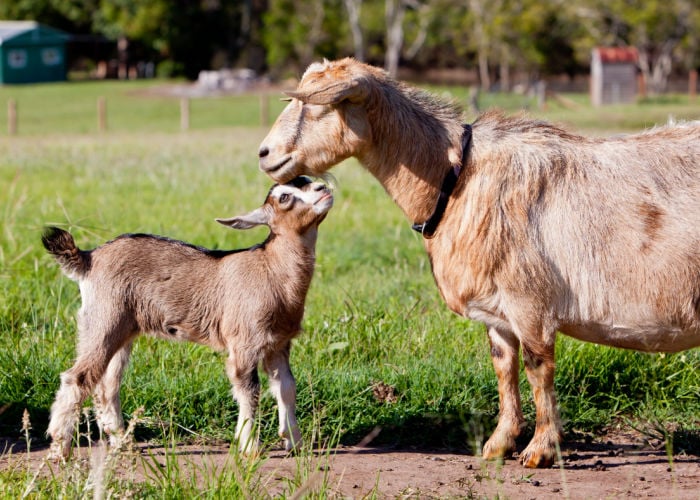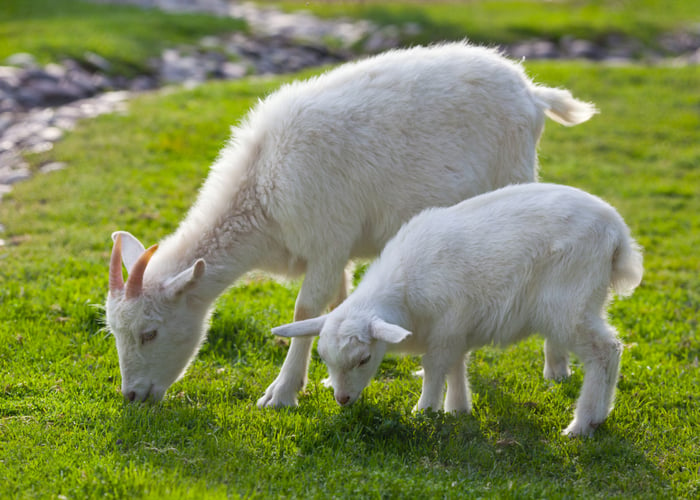If you’re a novice goat keeper, you’re probably wondering what can baby goats eat.
Caring for a baby goat can be an incredibly rewarding albeit nerve-wracking experience, especially
Navigating nursing, bottle feeding, weaning, and offering well-balanced nutrition feels overwhelming at first, but we assure you it’s not as difficult as you’re thinking and quite easy to get the hang of.
If you’re wondering just what baby goats can munch on, then this blog post has all the information you need.
We’ve got everything covered so you can keep your sweet fluffy kid well-fed and happy.
Read on to learn more about exactly what constitutes a proper diet for a baby goat.
What Can Baby Goats Eat: Foods You Can Give Them
All baby goats should have unlimited access to roughage (grass, hay, alfalfa, etc.) starting as early as a few days old.
Most baby goats can have up to a pound (3 cups) of pellets per day as soon as about a week old.
There are other foods you can offer baby goats in limited quantities, too, such as:

- 小块的(切碎或粉碎)fruits-watermelon,pples, grapes, bananas, apples, pears, cantaloupe, strawberries, raspberries, blackberries, huckleberries, and honeydew.
- Vegetables (cut up or smashed)—carrots, lettuce, spinach, broccoli, pumpkins, summer and winter squash, celery, potatoes, and green beans.
- Forage—evergreen needles (pine is best), dry and crunchy leaves (never from fruit trees), thorn bushes, bark (never from fruit trees), some flowers, clover, tree limbs, saplings, handfuls of grass (not grass clippings), and climbing vines such as honeysuckle or kudzu.
- Herbs, in very small quantities.
What Can Baby Goats Eat: Foods They Shouldn’t Eat
There is a myth that goats will avoid anything that is dangerous for them, and while this may be true for many, it does not apply to all goats.
Take a quick look at this list and memorize as much as possible.
Better yet, bookmark this page for future reference to make sure you don’t accidentally harm your four-legged kids.
- Fruit pits (and parts of trees or plants with fruits that have pits). Cherries, avocados, peaches, plums, apricots, and mangoes, plus all parts of the plant, are not safe for goats of any age.
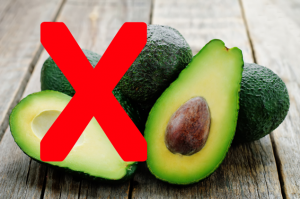 Milkweed
Milkweed- Lilacs
- Lily of the Valley (plus many other lily plants)
- Rhubarb leaves
- Holly trees and holly bushes
- Nightshade vegetables
- Garlic
- Onion
- Chocolates
- Foods with added sugar
- Foods with caffeine
- Meat, even in small amounts
- Citrus fruits– these aren’t toxic, but they make it difficult for the goat’s rumen to properly digest, so avoid them.
- Avoid most ornamental trees, flowers, bushes, and grasses. They are usually foreign to goat diets and may or may not be detrimental to their well-being.
Bottle Fed vs. Nursing Baby Goats
There are valid pros and cons to both methods of feeding your new goats; it’s up to you to decide which is more beneficial for your situation.
Bottle-feeding baby goats gives you a great connection with them.
These babies will be much friendlier with you, which will serve you well if you intend to work closely with them—like milking or shearing them.
If you have dairy goats, bottle feeding is beneficial because it allows you to collect more of the milk from the dam.
You can either milk her and then bottle feed the baby or offer the baby some milk replacer.
The potential downsides to bottle-feeding are that the goats might be a little too connected to you.
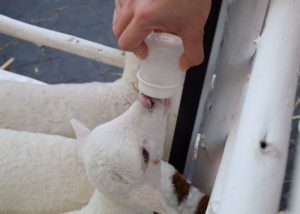
Bottle-fed bucks are much more dangerous because they do not fear humans and are much more likely to ram and injure (or potentially kill) their handlers.
If you’re raising your goats for meat consumption, it can be more emotionally difficult to let go of them when it comes time to process them as adults.
Bottle feeding also takes much more of your time and money too.
You have to be in the barn with your goats on a schedule, often six to eight times a day in the beginning.
How Much Milk Does a Baby Goat Need?
If your baby goats are nursing from their dams, then you likely won’t need to worry about the quality or quantity of the milk.
As long as you know the signs of malnutrition and dehydration (we cover that in the next two sections), you probably won’t need to do anything.
If you opt to bottlefeed your goat(s), though, you’ll need to very carefully follow the instructions on your milk replacer packaging and have a good understanding of how much they need (and how often to provide it).
Below is a good chart to help you get started.
For Full-Size Goat Breeds
AGE |
OUNCES PER FEEDING |
HOW OFTEN TO FEED |
0-2 days |
3 to 6 | Every 3-4 hours (6-8 times a day) |
3-21 days |
6 to 10 | Every 6 hours (4 times a day) |
22-42 days |
12 to 16 | Every 8 hours (3 times a day) |
43-70 days |
16 | Every 12 hours (2 times a day) |
| 71-84 days | 16 |
Every 24 hours (Once a day) |
For Miniature-Size Goat Breeds
AGE |
OUNCES PER FEEDING |
HOW OFTEN TO FEED |
0-2 days |
2 to 4 | Every 3-4 hours (6-8 times a day) |
3-21 days |
6 to 8 | Every 6 hours (4 times a day) |
22-42 days |
12 | Every 12 hours (2 times a day) |
43-70 days |
12 | Every 24 hours (Once a day) |
71-84 days |
12 | Every 24 hours (Once a day) |
What Can Baby Goats Eat If They Can’t Nurse
If your new goat kid is unable to nurse, you’ll need to bottle feed instead.
Feeding Colostrum to Newborn Kids
Newborn goats need colostrum immediately, within the first few hours of life.
It’s difficult to find raw goat colostrum, but don’t fret because colostrum replacers are highly effective and nearly invaluable to have.
Replacers don’t have an “expiration date,” but it’s best practice to use the product within a year of opening it.
It’s also relatively inexpensive to buy too, which is why I suggest having at least one small container on hand during kidding season.
Feed two ounces of colostrum replacer powder for every four pounds that your baby goat weighs. Follow the mixing instructions on the package very carefully, and don’t use water that is too hot.
An ideal temperature is similar to your own body temperature, around 99-102 degrees Fahrenheit (38-39 degrees Celsius).
New goats should get theirfirst feeding within two to six hoursof birth.
They will usually take more milk during this feeding than their second and third bottle session—don’t worry if you notice this.
Give them more colostrum approximately every six hours until your goat baby is a day old. After 24 hours of age, you can slowly transition them into goat milk or goat milk replacer.
Around day two or three, your goat will start to consume more milk or colostrum. Feed accordingly.
是的,初乳营养密集的和至关重要的newborn goats. However, it is not as beneficial to feed it to kids older than 48 hours of age. When goat babies are two days old, their intestinal epithelium (stomach) is no longer as permeable to Igs molecules.
Because of this, it’s wise to transition to milk at this age.
Feeding Milk or Replacer to Goat Kids
Your first bottle-feeding choice is raw goat’s milk vs. goat milk replacement.
Milk Vs. Replacer for Baby Goats
Raw milk will come from another one of your goats or another farm in your community.
If you source milk from another farm, ensure that the milking doe is disease free and healthy—you don’t want to accidentally make your newborn sick.
Goat’s milk is the better nutritional option because it contains the living bacteria and antibodies your kid needs to thrive.
Cow’s milk is another alternative, though not as nutritionally beneficial as goat milk.
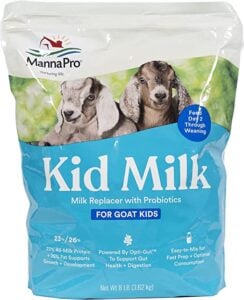 Always give whole milk to your kids, never 2% or less. Raw and pasteurized milk are both viable options.
Always give whole milk to your kids, never 2% or less. Raw and pasteurized milk are both viable options.
Goat milk and cow milk are usually more affordable than replacers too, which is another benefit.
The major downsides to cow and goat milk are finding reliable sources of them and their shorter shelf life.
Milk is typically “good” for a few days to a few weeks, depending on storage methods. Raw milk has a shorter shelf life than pasteurized.
Goat milk replacer has a fantastic shelf life, but it is typically more expensive and isn’t quite as nutritionally complete as the real thing.
You can find itonline here.
如何喂牛奶或代用品婴儿山羊吗
The first few days, you should feed your bottle-baby every three or four hours—about six to eight times a day.
As their stomach grows, the kid will be able to hold more milk for longer, meaning fewer feedings are needed.
Slowly, you can drop down to feeding every six hours (four times a day).
Once your baby is three weeks old, this can go to three feedings a day and then two feedings a day when they are six to eight weeks old.
We’ll go into more detail on specific amounts for each age in the section below.
How To Bottlefeed a Baby Goat
It takes patience and persistence to start bottle-feeding baby goats, especially when you’re first beginning.
Take your little kid in your lap, gently cradle them and hold their face up while pointing the nipple at an angle into their mouth.
You won’t need to set the goat in your lap every time, but it is a helpful method when first starting out.
不要担心如果婴儿不需要马上;some kids will show resistance by gritting their teeth or simply chewing on the nipple instead of sucking on it; just keep trying.
Once they figure out that milk is coming out, they will try to be more efficient, and those feisty little kids learn how to do things properly.
Be patient and keep trying. It will get easier with every feeding.
What If Baby Goat Won’t Take the Bottle
Keep trying, but adjust your techniques and tools.
Try letting the baby stand instead of sitting or lying down. They naturally stand up or kneel on their knees to eat; try those more natural positions.
Feed smaller amounts more often too.
It’s much more natural for baby goats to eat more often with smaller portions than for them to eat larger portions at smaller intervals. It may take time for their stomach to adjust.
Swap nipples. Use a different goat bottle nipple, or even try a human baby bottle nipple.
Sometimes a different tool is a difference between a daily struggle and an effortless latch.
What Can Baby Goats Eat:When To Wean Them
Some farms opt to wean goats at one month, but most people agree that at least two months is ideal.
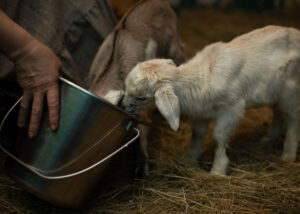
The Ohio State Universitystudied weaning dairy goats in 2020. Here are the key takeaways from that:
- Weaning should be done based on the kid’s weight and amount of concentrate eaten, not age. Wait until the baby is 2.5 to 3 times their birthweight before weaning. If you can wait one month past this milestone, you can “reduce stress, improve growth, breeding success, and production in the first lactation.”
- Allowing kids to have access to solid feed soon after birth and fresh water helps their rumen development for the switch from a milk-based to a solid diet. Feed about 1% of their body weight in solid foods before weaning.
- To prevent weaning shock, a gradual reduction of milk should be implemented over several days.
- Stacking stressors such as disbudding should be avoided close to weaning; sick kids may also require more time on milk before they can be weaned. If you have multiple stressors (like disbudding, illness, injury, castration, or vaccinations) that you need to do, try to wait at least one week between each.
- With proper preparation and monitoring, producers can ensure that kids transition smoothly from milk-based to solid diets while maintaining growth and welfare.
Allowing kids to nurse for longer is beneficial for their short and long-term health.
The drawback to extended nursing or bottle-feeding is that it takes the mother’s nutrients for longer, is more expensive than weaning, and is more time-consuming for you.
How To Wean a Goat From Milk to Solid Food
Weaning is the simple act of gradually giving less milk and more solid food.
But there are quite a few factors you should keep in mind, plus some handy tips and tricks to keep up your sleeve during the process.
- Supply plenty of water. Adults and babies should have free access to clean, fresh water at all times. Make sure the water is easy for the baby to reach. If the bowl or bucket is low, can they still reach the water to drink? Pay attention that it isn’t too deep either; anything more than a foot deep poses a drowning risk.
- Add electrolytes to the water during the weaning process. Weaning is stressful, so electrolyte supplements are a great way to keep up strength and encourage more water consumption.
- Offer free-choice hay or grass, depending on the season, availability, and your setup. The sooner you introduce roughage, the better their rumens will adapt and develop. A goat’s diet should becentered around high-quality forage(not pellet feed). All kids should have free access to minerals, too (unless it’s already in the feed, then it may not be needed).
- Consider offering pellet feeds to replace the milk. 16 to 22% protein creep pellet feed is great. You can start offering pellet feed from day two of life. If you start offering pellets this early, go with higher protein (22%). If you offer pellets later, at the start of the weaning process, you can go lower (16-18%). Kids can get 1-3 cups of grain per day. If you have multiple kids, monitor intake carefully so a few aren’t gorging themselves (and starving the others) on grain or pellets.
- Make the transition as slow and gradual as possible. Weaning should take 1-2 weeks to complete. Slowly give less milk at fewer intervals every day. If possible, fill these feeding voids with enrichment for your goats, like human socialization, playmate playtime, and new pasture exploration.
Deficiencies Related to Feeding You Should Look Out For In Baby Goats
Malnourished
If your new kid is not getting the nutrition he or she needs, that will become very obvious in a short amount of time. A starving kid will be weak and unable to stand up and nurse.
A malnourished baby is usually the result of kidding in too-cold temperatures, sickness, being shoved away by stronger siblings, or getting outright rejected by the mother.
For newborn kids, you need to immediately intervene by feeding colostrum.
If the kid can stand and nurse, do that. If they cannot, you will need to tube-feed the colostrum to them. You can add a bit of molasses to the tube-fed colostrum to help them gain energy faster.
Before doing this, though, check the baby’s temperature via the rectum. If the temperature is under 100 degrees Fahrenheit, they will likely die.
A low body temperature indicates that blood is not getting to essential organs like the stomach, and the milk or colostrum will not be digested properly. Instead, it will turn toxic and kill the goat baby.
If your baby is too cold, you may:
- Bring them inside to warm up (in your house or vehicle), and vigorously rub them with a blanket or towel to warm them back up.
- Set the baby inside a plastic bag (with the neck and head safely sticking out of the top for air) and then place the plastic bag into warm water. This is a fast way to warm the baby without getting them wet. You can place the baby directly into warm water, but you need to dry them fully before taking them back outside.
- Gently use a hair dryer on a low setting to bring the kid up to temperature. Be careful not to accidentally burn the baby with the hair dryer. Keep it moving, and mind the ears because that loud noise can hurt their new ears.
- Your baby will likely be very weak during this process; rub molasses or Karo on their gums for a quick “pick me up.”
Dehydrated
One of the quickest and easiest ways to tell if a goat (baby or adult) is dehydrated is to pinch the skin on the side of their neck.
Pinch the skin, hold it for a few seconds, and then let go. If the skin bounces back and unfolds itself immediately, your goat is well hydrated.
如果皮肤似乎认为,掐的位置,holding a “tent” form, then your goat is dehydrated.
And just an FYI—you can use this quick method to test dehydration in other animals too, like horses, cattle, hogs, and even deer.
Do You Have a Floppy Kid or a Weak Kid? Misdiagnosing is Deadly
Floppy kids are the result of overfeeding, while weak kids are the result of underfeeding.
Misdiagnosing here will be fatal because you have to make drastic changes quickly.
And the actions you take are completely opposite, depending on if your kid has floppy kid syndrome versus weak kid syndrome.
What Is Floppy Kid Syndrome?
Floppy Kid Syndrome wasn’t something that farmers or homesteaders dealt with much until the early 1990s.
When Americans imported Boer goats,the largest goat breed in the world, to the United States, they treated these goats very differently than they were used to.
Boer goats initially roamed on the ranges of Africa, getting very little human interaction and never being confined.
They are a hardy breed that really doesn’t need much intervention.
Well, when Boer goats came to America, they were suddenly confined to small lots or pens with their kids.
On the range, the dams let their kids nurse for short periods but frequently.
In confinement, the kids could nurse frequently and for much longer, especially since the mothers were preoccupied with stationary grains or bales of hay.
These baby goats had far too much milk and intake more than they could digest.
This undigested milk in their stomach turns toxic (enterotoxemia), and that leads to a painful death.
This usually happens around a week to a week and a half of age once the milk has had enough time to go toxic.
How to Treat Floppy Kid Syndrome
Once you are certain your kid has floppy kid syndrome, remove him or her from the dam immediately, and do not bottle feed for the next three days.
The goal is to clear out that toxic milk before it’s too late.
Substitute the milk or milk replacer with remnant electrolytes likeReSorborBounce Back.
Give small amounts of baking soda to alleviate some of the pain and neutralize the toxins. You may have to use a tube if your goat is unable to hold up the head or stand.
Milk of magnesia will help push out some of the bad milk through and out of the baby’s body.C&D Antitoxinvaccine is an effective preventative too.
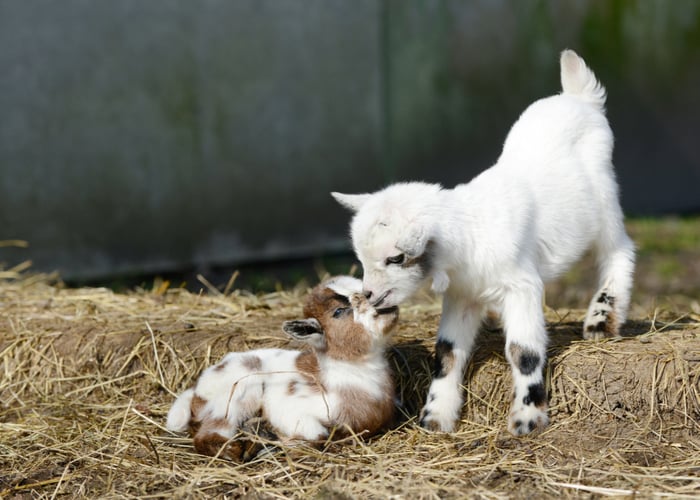
What Can Baby Goats Eat – FAQs
What Can You Feed Baby Goats Besides Milk?
All baby goats should have unlimited access to roughage (grass, hay, alfalfa, etc.) starting as early as a few days old.
Most baby goats can have up to a pound (3 cups) of pellets per day as soon as about a week old.
Limited quantities of fruits and vegetables are okay too.
Can Baby Goats Eat Human Food?
It’s best if baby goats are fed goat-like diets, such as milk, milk replacer, roughage, forage, pellets, and minerals. After a few months of age, after the baby has successfully weaned and appears healthy and growing, you can offer up some human foods in moderation. Fruits, vegetables, and small portions of peanut butter, crackers, bread, or other baked goods that are low in added sugars.
What Is The Closest Thing To Goat Milk?
Milk replacers or cow milk is the most goat-milk-adjacent options.
Both are good options for bottle-feeding baby goats when you don’t have access to goat milk.
Do Baby Goats Eat Anything?
Baby goats eat a surprising amount of food every day!
Many baby goats will drink anywhere from 18 to 128 ounces of milk a day, plus 3-4% of their body weight in pounds in roughage (¼ to ½ a pound) and up to a pound (3 cups) of pellets per day.
Do Baby Goats Need Water?
Baby goats always need constant access to clean and fresh water—regardless of if they are bottle-fed or are nursed by their mother.
They may not drink a lot of water, but it’s essential for them to have access to it from the start.
What Can You Feed Baby Goats – Final Thoughts
Knowing what you can feed baby goats is important as it could mean the difference between having a happy and healthy kid, to a sickly one.
Remember that there are a lot of great ways to provide them with the nutrition they need—from having them nurse from their mamas, bottle feeding them, and later on, to weaning them.
Just as you would care for a child, seeing a baby goat grow to be playful and generally happy is the best feeling ever for every keeper.
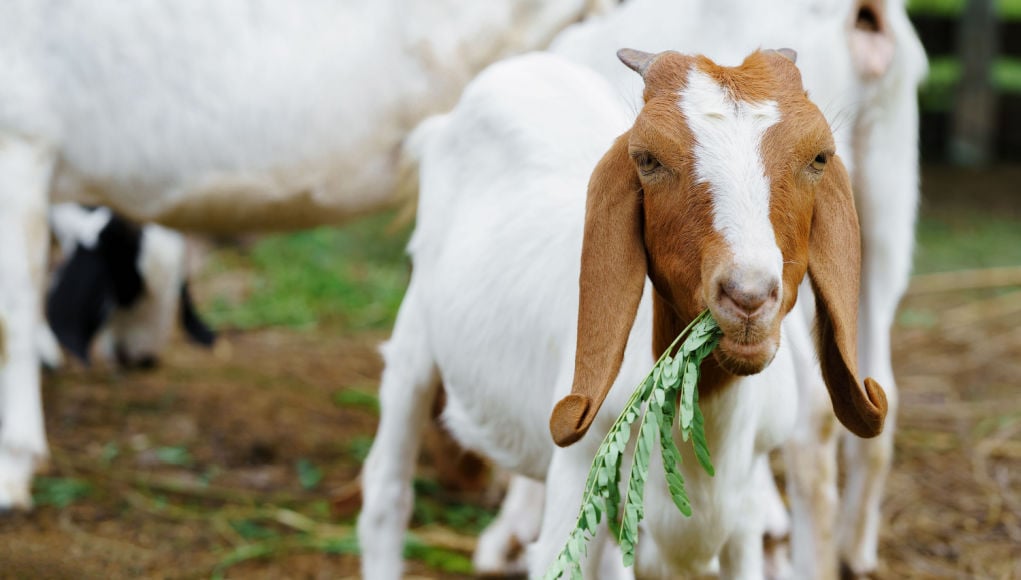
 Milkweed
Milkweed